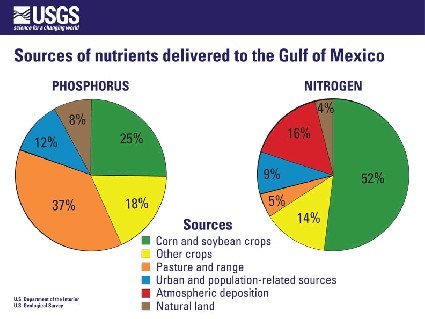 Last Thursday, a writer on a blog funded by the National Corn Growers Association excoriated me for my post on the Gulf of Mexico dead zone and its relationship to corn production. The author, Missouri Corn Growers Association Communications Director Cathryn Wojcicki (who tweets as @cornycate), dismissed my post as the “rantings of an elitist with an anti-corn agenda.” She also found the piece “snobbish and completely out of touch with the majority of hard-working Americans.”
Last Thursday, a writer on a blog funded by the National Corn Growers Association excoriated me for my post on the Gulf of Mexico dead zone and its relationship to corn production. The author, Missouri Corn Growers Association Communications Director Cathryn Wojcicki (who tweets as @cornycate), dismissed my post as the “rantings of an elitist with an anti-corn agenda.” She also found the piece “snobbish and completely out of touch with the majority of hard-working Americans.”
Fine. In fact, reading over the post, I could have done much better acknowledging the critical role of cheap food in an economy that seems structurally designed to keep wages stagnant. (As a journalist, I’m all too familiar with wage stagnation.) By sneering at “cheap food,” I can see how I come off as snobbish. Also, when discussing the various problems of industrial corn production, I should always emphasize that the Corn Belt’s farmers themselves are not really to blame. Few activities in American life have been as manipulated by government policy and corporate interest as grain farming in the Midwest.
Giant grain traders (Archer Daniels Midland and Cargill and company), along with giant cheap-grain consumers (meat titans Tyson and Smithfield and others), and giant seed, chemical, and other input suppliers (Monsanto, Syngenta, et al) are the main shapers and beneficiaries of a U.S. farm policy that encourages maximum production of corn. When we gawk at the Gulf dead zone, or marvel at the damage caused by vast animal feedlots, we should aim our ire at these institutions — not at corn farmers, who are simply striving to survive under extremely challenging conditions.
All of that said, Wojcicki didn’t just challenge my analysis. She also attacked my facts. And to that, I must respond — jab by jab.
Hypoxia hypocrisy
In an attempt to debunk my linking the dead zone to corn production, she asserts that “every river has a hypoxia zone”; that “sources other than farming contribute to the nitrogen found in the Mississippi River,” such as urban areas and golf courses; and thus “targeting only the corn industry makes no sense.”
All of this ranges from disingenuous to nonsense. For my next Victual Reality podcast, airing this week, I interviewed Nancy Rabelais, a leading hypoxia scholar and the executive director of the Louisiana Universities Marine Consortium (LUMCON), which tracks the size of the Gulf dead zone. She told me that while all rivers sweep nutrients into the sea, dead zones do not always, in fact, result. In some rivers, the flow rate and other natural factors disperse the nutrients sufficiently such that no hypoxia occurs.
All of that is a sideshow, though. The question is what drives dead zones — specifically, what drives the one that annually arises in the Gulf, the second-biggest one on the planet? What are the sources of nutrients (nitrogen and phosphorous) that feed the algae blooms that blot out life in a Massachusetts-sized swath? Until the 1970s, hypoxia was not a major problem in the Gulf. By 1985, when LUMCON first started measuring, the hypoxic zone had reached 10,000 square kilometers. Today, they typically average 20,000 square kilomters.
 Unhealthy nutrients: nitrogen and phosphorous from corn gush into the Gulf. Chart: USGSWhat’s the source of the nutrients? The U.S. Geological Survey has answers (see chart, right).
Unhealthy nutrients: nitrogen and phosphorous from corn gush into the Gulf. Chart: USGSWhat’s the source of the nutrients? The U.S. Geological Survey has answers (see chart, right).
Turns out that corn and soybean fields deliver 52 percent of the nitrogen and 25 percent of the phosphorous that end up in the Gulf every year. Corn and soy contribute nearly six times as much nitrogen, and twice as much phosphorous, as “urban and population-related sources,” the scapegoat cited by Wojcicki.
Let’s drill down a little deeper. For nitrogen, “natural land” and “atmospheric deposition” contribute a combined 20 percent of the load going into the Gulf. Those are fixed factors, not related to human activity. If we take them out and look at human-induced contributions to the Gulf’s nitrogen load, we find that corn and soy contribute 65 percent of the total.
Now, corn and soy operate as an agricultural system; they are grown in rotation over a vast swath of the Midwest. It bears noting that of the two, corn is by far the greater nitrogen user. Soybeans, a legume, fix a good deal of the nitrogen they use naturally from the atmosphere.
So it’s undeniable that corn production is by far the dominant contributor of nitrogen entering the Gulf. Targeting the corn industry makes perfect sense.
Biofuelish battles
In my post, I cited the U.S. government’s ever-rising ethanol mandates and surging demand for corn from China as factors that will spur greater corn production in coming years — and thus larger dead zones in the Gulf. These are “myths,” Wojcicki insists. “The ‘ethanol mandate’ is actually a renewable fuels mandate that guarantees our country lowers the greenhouse gas emissions that lead to climate change and increases energy independence,” Wojcicki writes.
True, the policy’s official name is the “renewable fuel mandate,” but what it calls for is dramatically increased corn-ethanol production. (It calls for even greater cellulosic ethanol production — but cellulosic ethanol remains largely nonexistent.) As recently as 2005, as figures from the Renewable Fuels Association tell us, U.S. producers made less than 4 billion gallons of corn-based ethanol. But then Congress, abetted by President Bush, started dramatically ramping up mandates for ethanol. In 2009, producers churned out 10.6 billion gallons. By 2015, if the mandate remains in place, they will be producing 15 billion gallons — a 44 percent increase over the 2009 level in just five years. And producers will maintain production at 15 billion gallons through 2022.
This gusher of ethanol from the heartland will likely spell disaster in the Gulf. In a 2008 paper published by the Proceedings of the National Academies of Sciences, researchers stated flatly that “Nitrogen leaching from fertilized corn fields to the Mississippi-Atchafalaya River system is a primary cause of the bottom-water hypoxia that develops on the continental shelf of the northern Gulf of Mexico each summer.” They conclude that ramping up corn ethanol production to 15 billion gallons will “increase the annual average flux of dissolved inorganic nitrogen (DIN) export by the Mississippi and Atchafalaya Rivers by 10-34%” — corresponding to ever-larger dead zones.
As for China, Wojcicki writes, “a single buy … is not a trend. It is one buy.” But as I showed in a recent post, China is actually in the process of dramatically ramping up corn imports, from zero in 2008 to 15 million metric tons by 2015. That’s enough
to increase global corn export demand by 18 percent, I calculate — meaning higher corn prices and more incentive for farmers to maximize yields with increased fertilizer application and plant more land to corn.
Nitrogenuflection
Next, Wojcicki derides my contention that “Corn plants typically only take up 40 percent of the synthetic nitrogen applied by farmers.” She ripostes: “Would farmers put down something as expensive as nitrogen if 60 percent washed off?”
Unfortunately, yes. It’s hard to come up with precise numbers for nitrogen-use efficiency (NUE) — the percentage of applied nitrogen taken up by plants — because it varies widely year to year and even field to field. But the consensus is that NUE for U.S. corn is well below 50 percent. (See, for example, the 2007 Illinois Fertilizer Conference Proceedings.)
But farmers aren’t wasting nitrogen because they’re profligate, or bad land stewards. Instead, it has to do with the physiology of plants, as Peter Vitousek, a professor of biology at Stanford and a leading scholar on the nitrogen cycle, explained to me when I was doing research for Grist’s Nitrogen series this winter. Vitousek told me that under the very best conditions, corn farmers can achieve NUEs of only 60 percent at most. He explained that during the growing cycle, plants’ nitrogen needs vary by the day. To ensure that plants have sufficient nitrogen on their heavy feeding days, farmers essentially have to overapply. And when there’s severe pressure to maximize yields, such as that faced by U.S. corn farmers, heavy overapplication becomes a matter of survival. And that spells doom for large swaths of the Gulf, where much of that excess nitrogen ends up.
Corn fed up
Finally, Wojcicki lashes out at me for contending that corn produces “low-quality meat” and “low quality fuel,” i.e, ethanol. I was thinking about how grass-fed beef has a significantly better fat profile than grain-fed; and that cows fed corn tend to get sick, making them dependent on antibiotics to survive until slaughter.
As for corn-based ethanol, I meant that a gallon of it has two-thirds the energy of a gallon of gas; and according to some analyses, has a significantly greater greenhouse-gas footprint than gas. For me, it’s patently absurd to attempt to replace fuel from energy-rich petroleum with fuel from energy-light corn. The real answer to fossil-fuel addiction isn’t to grope for — and commit billions of dollars in federal subsidies to — weak gasoline substitutes like ethanol; it’s to reduce reliance on the car and increase investment in mass transit.
All in all, Wojcicki’s outrage at my post produced a cloud of misinformation. But for all the obfuscation, her screed leaves my factual claims fully intact — and does nothing to change my opinions.



